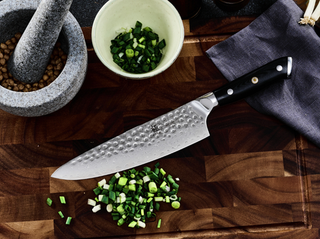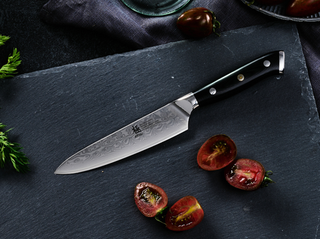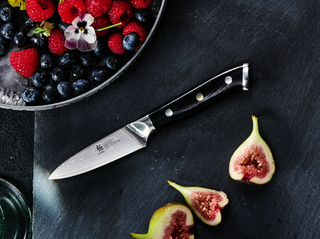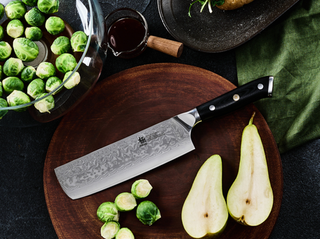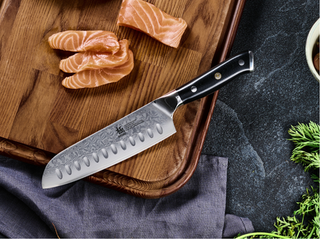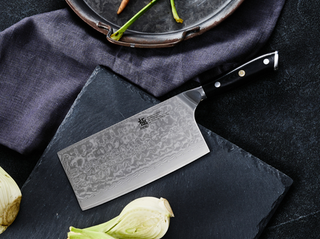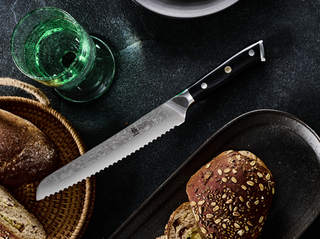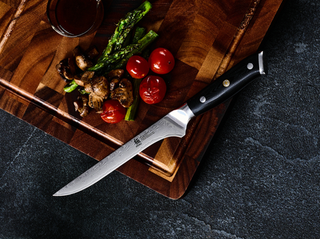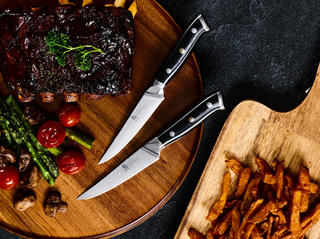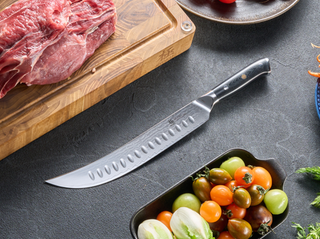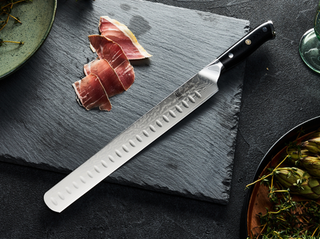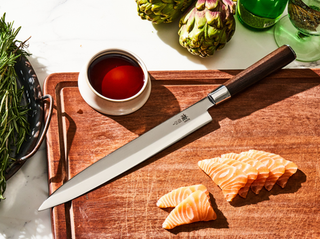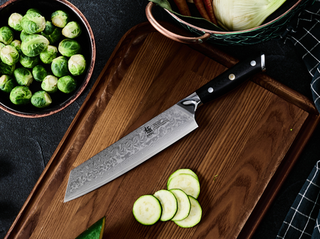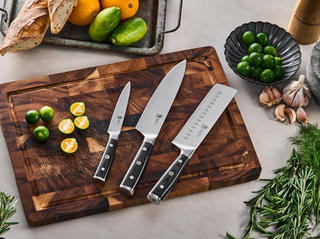If you are like many home cooks, there might have been a time when you were following a stir-fry recipe and suddenly, you saw the instruction “cut vegetables on the bias.” You may have paused for a minute and thought: “Isn’t that something fashion designers do?
Cutting on the bias exists in the culinary world, too, and it is an important skill that works mostly with vegetables. Even better, understanding and mastering bias cuts and how they are used in cooking can completely change the texture, look, and even cooking time of your veggies.
So let’s break it down: what does a bias cut mean in cooking, why is it different from the kind used in clothing, and how (and when) should you do it? Also, what kinds of Japanese knives can help you perfect this technique?

What Does "Bias Cut" Mean in Cooking?
In cooking, a bias cut is when you slice a vegetable at a diagonal angle (usually between 30° and 45°) rather than straight across. Cutting vegetables on a bias creates longer, more oval-shaped pieces instead of short rounds or chunks.
Bias-cutting vegetables has practical benefits when it comes to cooking and presenting your dish. Bias-cut vegetables cook better, the shapes hold up better during cooking (especially for stir fries), and the longer, thinner cuts give your dish an “Asian inspired” aesthetic, which is very desirable to most people.
Benefits of Bias Cutting in Cooking
| Benefit | Why It Matters |
| More surface area | Helps vegetables cook faster and absorb sauces better |
| More elegant appearance | Great for presentation in plated dishes or garnishes |
| Better texture in stir-fries | Creates thinner, faster-cooking pieces without losing shape |
| Even cooking | Long, thin diagonal slices heat more consistently |
| More professional look | Widely used in Asian cuisines for polished, elongated cuts |
When to Use a Bias Cut (and Which Ingredients Benefit Most)
Bias-cut vegetables work best for dishes like stir-fries, salads, soup toppings, and different dishes that involve long, cylindrical, or stalky vegetables. You can always use a bias cut for vegetables, especially when speed and aesthetics matter. They’re commonly used in:
- Stir-fries (e.g., carrots, celery, green beans, bell peppers)
- Sautéed side dishes
- Soups and ramen toppings
- Asian cuisine prep (like in Chinese, Japanese, and Thai cooking)
- Salads and cold dishes when presentation matters
- Plated dishes where garnish style affects plating and appearance

Vegetables Commonly Cut on a Bias
Basically, any vegetable that can be cut into long, thin strips can be cut on the bias. The most common ones are
- Carrots
- Celery
- Zucchini or cucumber
- Green beans
- Scallions/green onions
- Asparagus
- Leeks
- Baby corn
- Daikon radish
How to Cut Vegetables On the Bias(Step-by-Step Guide)
When it comes to cutting vegetables on the bias, the method you choose must correspond to the type, size, and texture of the vegetable you are cutting. Overall, there are two ways to cut vegetables on the bias:
- The basic bias cut: works for straight, long vegetables like carrots, cucumbers, and celery
- The roll cut: works when you need longer flared bias slices
Basic bias cut (for straight/long vegetables)
- Trim and clean: Wash the vegetable (s) and trim off the ends. Peel if necessary.
- Cut a flat base: If the vegetable is round (carrot, cucumber), cut a thin slice lengthwise to make a flat side so it won’t roll. Then, place the flat side down.
- Position the vegetable: Lay the vegetable so its long axis runs roughly from left to right in front of you (or lengthwise away from you).
- Set your angle: Hold the knife so the blade meets the vegetable at a 30–45° slant instead of 90°.
- Use the claw: Grip the veg with your non-knife hand in a claw (fingertips curled under). Let your index finger rest on the spine only if needed for control.
- Slice with a forward-down motion: Slice by pushing the knife slightly forward and down in a smooth motion (rocking or forward-slicing), keeping each slice the same thickness. Move your guiding finger back the same distance after each cut.
- Stop at the end: When you get near the end, lay the small stub flat and slice straight across (or chop it) to avoid awkward tiny pieces.
The Roll-cut (creates longer, flared bias slices)
Good for cylindrical veg when you want larger diagonal ovals (common in stir-fry prep):
- Start with the basic bias cut.
- After each cut, rotate the vegetable a quarter-turn toward you (or a bit less) so subsequent cuts are slightly offset. This creates a series of elongated, angled ovals.
- Continue until finished.
Tips for Bias Cutting Small/Soft Vegetables (scallions, chives)
- Lay the stalk at about 30–45°.
- Make quick, shallow diagonal slices using a rocking motion.
- For very thin bias slices, angle the blade more shallowly and use light, fast motions.
Tips for Cutting Wide/leafy vegetables on the Bias
You can bias-slice to get longer half-moon pieces: cut lengthwise at an angle to yield elongated half-moons with more surface area for browning.
As long as your knife is sharp, this method of bias cutting vegetables should work for carrots, celery, zucchini, cucumber, scallions, and many others.

Best Knives For Bias Cutting in Your Kitchen
For bias cutting, you generally don't need any fancy cutting equipment. You should be able to cut vegetables on the bias with the tools currently available in your kitchen. The key is that the kitchen knife should be sharp: a dull blade can slip and make uneven cuts (or worse, cause injury).
However, if this is a vegetable cutting technique that you would like to employ frequently in the long run, here are a few precision tools that will help greatly:
- For bias cutting, the ideal knife is a chef's knife. It is versatile and provides great control and stability. For longer vegetables like carrots, go for a chef's knife with a longer blade. An 8-inch chef knife would be ideal.
- A santoku knife is also a great option for bias-cut vegetables and cutting vegetables in general. A 7-inch Santoku knife will give you clean, straight, and diagonal cuts
- Another great option for cutting vegetables on the bias would be a utility knife. These are good for smaller and softer vegetables (like green beans, leeks, etc) as well as slim items like scallions or asparagus.

Understanding Bias Cut: Clothing vs. Cooking
Practically speaking, the concept of a bias cut is similar in clothing and cooking: it involves cutting diagonally instead of straight.
However, the reason for cutting vegetables on the bias is very different from the reason for cutting fabric on the bias: In fabric, it’s about flexibility and drape. In vegetables, it’s about presentation, speed of cooking, surface area, and mouthfeel.
Here are some of the main similarities and differences between bias cuts in cooking and bias cuts in clothing:
| Bias Cut in Clothing | Bias Cut in Cooking |
| Fabric is cut at a 45° diagonal from the grain | Similar, but less rigid. Vegetables can be cut at any angle between 30° and 45° |
| Follows the fabric’s most flexible direction | Creates longer, more elegant slices |
| Produces garments that drape smoothly on the body | Affects appearance, cooking time, and texture |
Final Thoughts: Is Learning Bias Cutting Worth It?
Absolutely. Whether you’re a home cook aiming for restaurant-style presentation or a pro wanting consistency and speed, mastering the bias cut is a simple skill that pays off in both looks and performance.
It’s not just about style: it improves cooking time, flavor absorption, and texture, especially in fast-cooked dishes like stir-fries and sautés.
Here are 6 essential knife grips you may want to master for more efficient, speedy, and presentable cutting in your kitchen.
